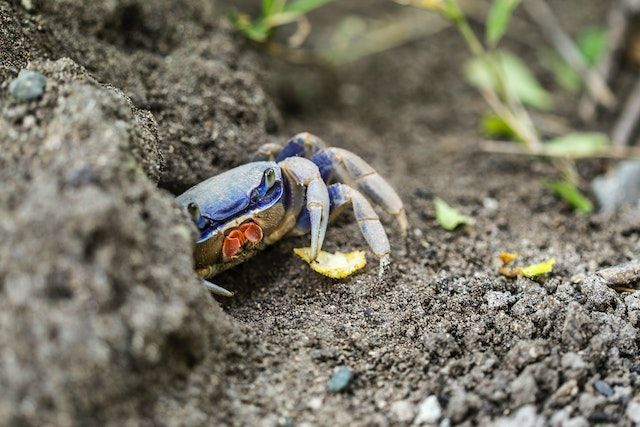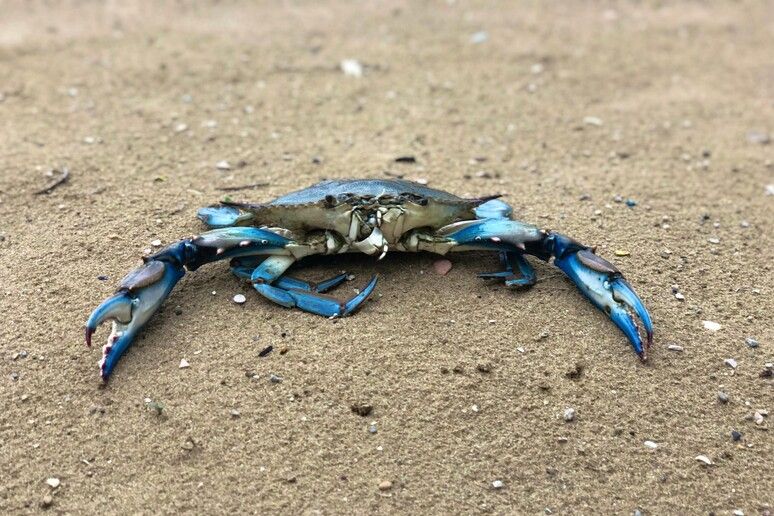The past always brings a present and a future. Today we look at updates on the Venice blue crab, which is a mysterious marine animal with intense color and exotic shape.
The essential information about the Venetian blue crab

The Venetian blue crab, also known as the "Very Very Blue" or "Blue Crab," is a species of crab native to the Mediterranean Sea, more specifically the Venice Lagoon.
The Venice Blue Crab is distinguished by its distinctive color, an intense cobalt blue, which makes it particularly fascinating and attractive.
Its coloration is due to the presence of a blue pigmentation called astaxanthin, which gives it such a striking hue.
The species
This species of crab lives mainly in the shallow waters of the lower Adriatic and the Venice lagoon, where it can be found in sandy, muddy or even vegetation-covered bottoms.
It is known for its great ability to blend in with its surroundings, thanks to its coloration, and for its powerful claws.
Type
The Venice blue crab is an omnivorous animal, feeding on a wide range of foods such as mollusks, crustaceans, algae, organic debris, and even dead fish. Its powerful claws are used to catch and break up its prey.
Pollution, deterioration of natural habitat and intensive fishing activity
Due to pollution, deterioration of natural habitat and intensive fishing activity, the population of the Venice blue crab has declined in recent decades. However, various conservation programs have been put in place to protect this species and preserve its habitat.
The Venice blue crab is of great ecological importance in the Venice lagoon, as it plays a key role in controlling the population of other invertebrates and maintaining the balance of the ecosystem.
Uniqueness
In addition, because of its unique beauty, the Venice blue crab has become an iconic symbol of the Venice lagoon and a popular subject for photographers and nature lovers.
In conclusion, the Venice blue crab is a fascinating and distinctive crab species living in the Venice lagoon. Its intense coloration and ecological role make it a species worthy of notoriety and conservation.
Veneto blue crab updates
The Venice blue crab is a species of freshwater crab that lives exclusively in the Venice lagoon, constituting an important ecological and gastronomic asset for the city and the entire region.
In recent years, some important updates and changes have been noticed regarding its presence and distribution within the lagoon.
Thanks to monitoring and research programs conducted by local institutions and scholars in the field, it has been possible to collect valuable data on the dynamics and updates of the Venice blue crab.
It was found that although it was initially thought to be a native crab, in fact this species is of American origin and was probably introduced to the lagoon in recent times through commercial channels.
Questions about the possible influence of blue crab on the lagoon ecosystem
This fact raised several questions about the possible influence of the blue crab on the lagoon ecosystem and native species.
Studies have shown that the blue crab may have a negative impact on local biodiversity as it feeds on endemic species and competes with other organisms for food resources and living space.
To address this issue, blue crab management and control plans have been developed to limit its spread and mitigate its impact on the lagoon ecosystem.
Some of the strategies adopted include the use of traps to capture and remove invasive shrimp, as well as the involvement of local people in educating and raising awareness about the importance of conservation of native species.
Updates on the Venice blue crab reflect the commitment of authorities and experts to protect the lagoon ecosystem so as to preserve its uniqueness and ensure the sustainability of fish resources.
However, ongoing monitoring and research continue to be critical to assess the effectiveness of management programs and adapt strategies to any changes or new challenges that may arise in the future.
Some negative aspects
In a short time, an accelerated proliferation of blue crab has caused a serious imbalance in the marine ecosystem of Italy's North Adriatic coast. Its rapid spread worries Venetian fishermen, as it consumes clam farms in just two days.
The blue crab is on the brink of being considered a culinary opportunity, but it could spell disaster for the Venetian lagoon and sea coasts.
The first Miami transport of Venice blue crab
A Venice-based company is focusing on the blue crab industry and has just started the first transport of a container with its flagship product, called "clam eater" packaged in a box (destined for sale in Miami).
Veneto's blue crab is transformed into biogas
Thanks to the Venetian company that will carry out the transformation into biogas, it will be possible to obtain about 200 kilowatt hours of electricity from one ton of blue crab. This will make it possible to take advantage of the Polesine scourge of clams and mussels to generate clean energy.
In addition, this solution will effectively dispose of the product and solve the storage problem. Currently, the companies involved in the trial could handle up to 20 tons of crab per day using three digesters, but if the initiative is extended to all biogas companies in the Veneto region, it could reach up to 100 tons per day.

